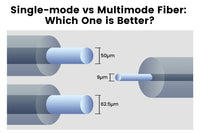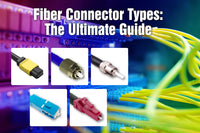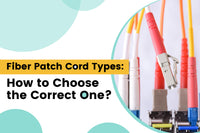Contents
Have you ever come across a special fiber optic cable terminated with a connector at only one end? This is known as a fiber pigtail. Fiber optic pigtails and fiber jumpers are different fiber optic products. How does a fiber pigtail differ from a standard fiber patch cord? What are the common applications of fiber optic pigtails? We’ll delve into everything about fiber optic pigtails in this article.
What is a Fiber Optic Pigtail?
A fiber pigtail refers to a special fiber optic cable that contains a connector at one end and bare optical fiber at the other end. The end equipped with a fiber connector is intended for connection to optical devices and the end with a bare fiber is typically spliced with other fiber optic cables. This design provides convenience for fiber optic networks, particularly for field termination applications, to enhance network performance and reliability.
Fiber Pigtail Types
There are many fiber pigtail types and we’ll deeply explore them in the following content.
By Fiber Type
Single-mode and multi-mode pigtails are two common types based on the optical fiber type. Single-mode fiber pigtails typically utilize OS1 or OS2 fibers, with a single-mode connector terminated on one end. The single-mode pigtail is capable of a transmission distance of up to 4km. Multi-mode pigtails are usually crafted from 62.5/125-micron or 50/125-micron multi-mode fibers. They are terminated with multi-mode connectors. Besides OM1 and OM2, a 10G multimode fiber pigtail is also available for higher bandwidth applications.
Fiber optic pigtails are most used in single-mode applications, but can also be used for multi-mode applications.
By Fiber Connector Type
Fiber optic pigtails can be categorized into several types based on fiber connector types, such as LC, SC, ST, FC, MU, E2000, and MPO pigtails. Each has its properties in specific applications.
- LC Pigtail: LC is the abbreviation of Lucent Connector.It is a fiber connector with a square plastic enclosure and 1.25mm ferrule (half the size of common connectors). The connector provides low insertion loss and back reflection. The small size and high performance make the LC pigtail especially suitable for high-density environments.
- SC Pigtail: SC refers to Square Connector. SC pigtail has a very similar appearance to the LC pigtail but it has a 2.5mm stainless ferrule. It stands out for its low cost and high performance.
- FC Pigtail:FC means Ferrule Connector or Fiber Chanel. The connector of the FC pigtail owns a screw-type structure and a ferrule with high accuracy.
- ST Pigtail: ST stands for Straight Tip.The pigtail is similar to the FC pigtail but without screw thread. ST refers to a fiber optic connector commonly used in the fiber splice tray. Durability and resistance to damage also make it widely used in outdoor applications.
The following chart lists the characteristics of four main types of fiber pigtails.
|
Pigtail Types |
Connector Structure |
Mating Cycles |
Applications |
|
LC Fiber Pigtail  |
A modular jack latch structure with a 1.25mm ferrule. |
500 |
High-density CATV, LAN, WAN, test, measurement, indoor applications, FTTH |
|
SC Fiber Pigtail  |
A square push-pull structure with a 2.5mm ferrule. |
1000 |
CATV, LAN, WAN, test, and measurement PON networks |
|
FC Fiber Pigtail  |
A round screw structure with a 2.5mm ferrule. |
500 |
General applications |
|
ST Fiber Pigtail  |
A bayonet structure with a 2.5mm ferrule. |
500 |
Telecommunications, industry, medical and sensor applications |
By Application Environment
According to the application environment, some fiber pigtails are designed for daily common use, whereas some fiber pigtails like armored fiber pigtails and waterproof fiber pigtails feature resistance to harsh environments including moisture, high temperature, and heavy rain.
- Indoor Fiber Pigtail: As the name suggests, indoor fiber pigtail is only suitable for indoor wiring. It has no extra protection but is enough for indoor use. The low cost and good flexibility make this pigtail the most commonly used type.
- Armored Fiber Pigtail: Featuring an additional protective metal layer, the armored fiber pigtail boasts better durability and provides robust shielding from common external damage. It is suitable for harsh environments, providing added protection.
- Waterproof Fiber Pigtail: The waterproof fiber pigtail has a stainless-steel waterproof and armored PE jacket with low loss and high return loss, offering great resistance to extreme environments. The waterproof fiber pigtail is usually equipped with awaterproof connector for optimal performance. Its exceptional resistance to extreme environments makes it a preferred choice for connecting backbone cables and optical receivers. The waterproof and anti-corrosion performance also makes it commonly used in outdoor fiber optic network construction such as CATV installations and military applications.
By Fiber Count
1, 2, 4, 6, 8, 12, 24, 48, and 72 strands are available in fiber pigtails. Different colors are coded on the fibers by the standard TIA-EIA-598-A. Typically, one fiber count is the most common pigtail in daily life.
By Polish Type
Based on the polish type, fiber pigtails can be categorized into PC, UPC, and APC pigtails. PC, UPC, and APC are related to single-mode and multimode fibers. Different polished interfaces of connectors can impact the return loss of fiber connectors.
- PC Fiber Pigtail: The PC fiber pigtail uses a physical contact connector. Most multimode fiber pigtails use PC connectors, but they are gradually replaced by UPC pigtails.
- UPC Fiber Pigtail: It stands for ultra-physical contact connectors with a slightly domed end face. It is regarded as the most common type for single-mode and multi-mode pigtails.
- APC Fiber Pigtail: It refers to “Angled Physical Contact”. APC fiber pigtail’s interfaces are polished at an angle of 8 degrees to reduce back reflection, which is often used in CATV, FTTx, etc.
Fiber Pigtail vs. Fiber Patch Cord
Fiber pigtails and fiber patch cords play distinct roles within fiber optic networks. Featuring different constructions, they are designed for different purposes and scenarios.
A fiber pigtail is usually a short fiber optic cable with a pre-installed connector on one end. A fiber patch cord, also known as a fiber jumper, has two connectors on both ends. A fiber patch cord can be split into two fiber pigtails.
Fiber patch cords are essential in establishing connections between various network devices, such as switches, servers, and fiber patch panels. They come in a variety of outer sheath materials, including ONFR, ONFP, and LSZH, catering to different environmental requirements. Available in different configurations and lengths, fiber patch cord provides flexibility in temporary or permanent network connections.
Conversely, fiber pigtails are primarily used in fiber optic splicing for permanent connection. They are also used for connecting fiber optic cables to termination points commonly found in optical components and assemblages.

Pros and Cons of Fiber Optic Pigtail
- Pros
- Easy installation: Pigtails are easy to install and connect to other devices quickly.
- Versatility: Various connectors and lengths are available for a wide range of applications.
- Low cost: Pigtails are less costly than full-length fiber optic cables.
- Simple wiring: Multiple strands of fiber can be put in one fiber pigtail together, which will reduce the mess of too many cables.
- Improved performance: The factory-terminated pigtail ensures high-speed and reliable signal transmission.
- Cons
- Vulnerability: The bare fiber on the fiber pigtails is susceptible to damage during installation and maintenance.
- Short length: Fiber optic pigtails are typically short in length, which may not be suitable for applications requiring long cable lengths.
Applications
Fiber optic pigtails can be used for a wide range of applications.
- Fiber Optic Networks
Fiber optic pigtails are a crucial component in fiber optic networks. Simple wiring makes it easier to install than direct cables. They are often used with optical devices like optical transceivers and optical splitters. What’s more, fiber pigtails can be used for regular tests and maintenance of fiber optic networks by connecting devices to the network.
- Telecommunications
With their flexibility and stability, fiber pigtails can also be used in telecommunications for a reliable and stable communication network.
- Data Centers
With its high bandwidth, low latency, and high security, fiber pigtails can process massive data in data centers.
With the increasing demand for high bandwidth and speed applications, fiber optic cables have been commonly used in many scenarios. The demand also drives the development of fiber pigtails in broader applications, including the Internet of Things (IoT), smart cities, environment sensing, health monitoring, and industrial automation.
Fiber Optic Pigtail Splicing
Fiber optic pigtail splicing is a common method to join two fiber pigtails. Mechanical splicing and fusion splicing are known as the most commonly used splicing methods. Mechanical splicing uses the mechanical splicer and an index-matching gel to join two fiber ends for quick and easy splicing. Fusion splicing joins the two pigtails by heating and melting them with a special fusion splicer to achieve a permanent connection. Compared with mechanical splicing, fusion splicing is a better way to join fibers together for its low loss and back reflection but can be more expensive. Wrong splicing will affect light transmission between two fibers. If you’re new to this, you’d better seek help from professionals.
Final Thoughts
Fiber pigtail plays a significant role in fiber optic networks. It is an effective solution to terminating your bare fiber or connect to fiber patch panels, saving costs and labor.
For more information on this topic, you can keep up on our blogs. While VCELINK offers general and basic information for our customers and other visitors to the website, it’s not professional advice.



Be the first one to comment.
Leave a comment